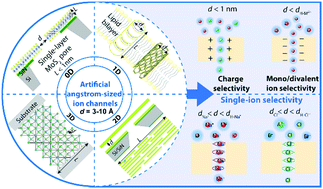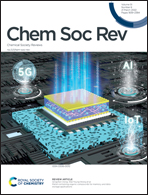Angstrom-scale ion channels towards single-ion selectivity
Abstract
Artificial ion channels with ion permeability and selectivity comparable to their biological counterparts are highly desired for efficient separation, biosensing, and energy conversion technologies. In the past two decades, both nanoscale and sub-nanoscale ion channels have been successfully fabricated to mimic biological ion channels. Although nanoscale ion channels have achieved intelligent gating and rectification properties, they cannot realize high ion selectivity, especially single-ion selectivity. Artificial angstrom-sized ion channels with narrow pore sizes <1 nm and well-defined pore structures mimicking biological channels have accomplished high ion conductivity and single-ion selectivity. This review comprehensively summarizes the research progress in the rational design and synthesis of artificial subnanometer-sized ion channels with zero-dimensional to three-dimensional pore structures. Then we discuss cation/anion, mono-/di-valent cation, mono-/di-valent anion, and single-ion selectivities of the synthetic ion channels and highlight their potential applications in high-efficiency ion separation, energy conversion, and biological therapeutics. The gaps of single-ion selectivity between artificial and natural channels and the connections between ion selectivity and permeability of synthetic ion channels are covered. Finally, the challenges that need to be addressed in this research field and the perspective of angstrom-scale ion channels are discussed.



 Please wait while we load your content...
Please wait while we load your content...